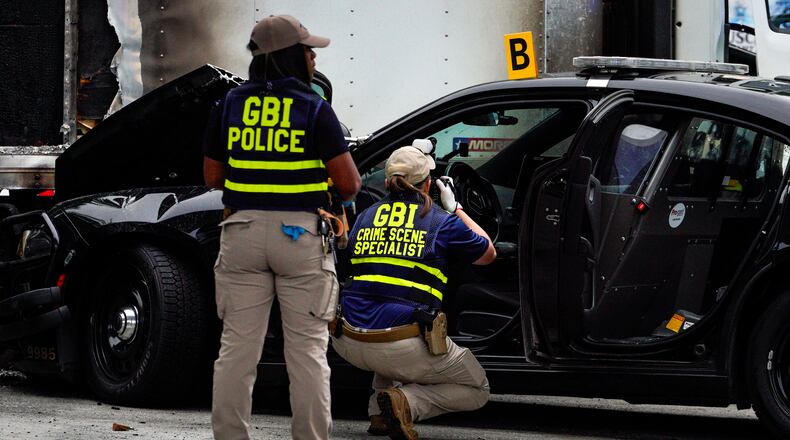Before police officers make the decision to draw their weapons and use force against a citizen, a list of things runs through their minds. It’s not an easy choice to make, officials explained.
“They’re making constitutional evaluations, they’re making ballistic evaluations, they’re making distance calculations, they’re in fear for their life, they’re thinking about their kid and their family at home,” said Chris Harvey, deputy executive director at the Georgia Peace Officer Standards and Training Council (POST).
But when an officer does pull the trigger or, in some cases, is the one being shot in the line of duty, the repercussions ripple through communities and law enforcement agencies. Debates are sparked and tensions rise, and investigators are left to try to uncover what caused an incident to escalate.
Shootings involving law enforcement have been increasing nationwide over the past decade. The 2014 killing of Michael Brown in Ferguson, Missouri — the flashpoint prompting many of Georgia’s police agencies to recognize the need for greater transparency — revealed that such shootings were actually being underreported to the FBI, a Washington Post investigation found.
It was Brown’s death that spurred action in Georgia, leading the GBI to become the agency to investigate most officer-involved shootings in the state.
Since 2014, the number of police shootings the GBI has investigated each year has generally been increasing, but more recently there has been a drop. As of July 10, the agency had investigated 43 such incidents in 2024, compared to 51 at the same time last year.
In exclusive interviews with The Atlanta Journal-Constitution, officials with the GBI, Georgia POST and two metro Atlanta law enforcement agencies found it difficult to explain the increases and decreases in recent years. But they were able to agree on ways officers and citizens can help keep such incidents from occurring.
For officers, communication and training can make a world of difference. For citizens, compliance is key, authorities said.
Communication, respect ‘goes a long way’
An officer can never overcommunicate to a citizen what is happening, said Cynthia Adkins, the first female division director of investigations at the GBI. She explained that clearly and calmly communicating why someone is being pulled over, searched, taken into custody or arrested can help prevent an encounter with police from turning into a shooting.
“There’s been plenty of times in my career where I have been in a tense situation, and just being able to communicate clearly and respectfully, that goes a long way,” she said.
One recent example involved a Camden County sheriff’s deputy who came under scrutiny last year after approaching a suspect’s vehicle with his voice already raised. Though the fatal shooting remains under investigation and Adkins couldn’t comment on it, she explained that an officer approaching a situation with a calm demeanor, explaining the law and situation, and properly introducing themselves can help keep an encounter peaceful.
On that October day, Leonard Cure was shot by Staff Sgt. Buck Aldridge after being pulled over for speeding on I-95 in a rural area just north of the Florida border. Body camera footage showed Cure stop his car on the interstate. Aldridge could then be heard immediately yelling at Cure four times to “step out” or “get out” of his truck.
The situation quickly escalated, with Aldridge threatening to use his Taser several times and Cure placing the officer in a headlock, according to the footage. Aldridge has not been charged in the incident.
Compliance is crucial
Citizens may not always agree with an officer, or they may determine what an officer did was not legal or respectful, but Paulding County’s recently elected sheriff, Ashley Henson, said compliance is crucial. He said keeping your hands visible, not making sudden movements and following directions can decrease the chances of a situation escalating.
It’s not worth it to flee from an officer, argue, yell, resist arrest or use a firearm, Henson said. Until someone has been searched, Kennesaw police spokesman David Buchanan added, an officer does not know if they are armed and any sudden movements may be perceived as potentially dangerous.
“If you’re stopped for something, listen to what the officer is saying, comply with what they’re saying, and if they’re wrong, that’s what court is for. Let the criminal justice system have an opportunity to work,” Buchanan said.
In Cobb County, a suspect was killed by officers in May after appearing to not comply, while a passenger in the vehicle who did comply was not injured by police gunfire. Clifford Jacoby Beck was fatally shot after trying to flee a traffic stop in a stolen box truck, the GBI said. The passenger immediately got out and complied with officers, but Beck struck a patrol vehicle before officers fired, officials said.
When someone doesn’t comply, Henson said officers are equipped with skills to de-escalate a situation, such as patiently listening, showing empathy, requesting a supervisor, partnering with mental health professionals and not making threats.
But officers aren’t able to control how a citizen or suspect acts in the moment, and that’s when proper training comes into play, officials said.
Police training on the rise
Starting in January 2025, new law enforcement officers in the state will be required to undergo double the amount of training in the academy as compared to officers now, who are only required to take part in 400 hours of training in various topics. Harvey said Georgia previously “ranked lowest in the country” for the minimum number of hours a recruit must go through.
Once officers officially join a department, they continue to train. That regimen includes de-escalation techniques, Taser and firearm use, crisis intervention and a myriad of other topics.
Kennesaw police are trying something a bit different by incorporating Brazilian Jiu Jitsu into their standard training. Buchanan said it instills confidence and provides police with the skills to be able to take control of a situation without using a weapon. For example, if a suspect were to place an officer in a chokehold, they would have the skills to free themselves and properly restrain the suspect without serious injury, Buchanan explained.
In the past decade, Kennesaw police were involved in only two officer-involved shootings, one in 2018 and another in 2019, GBI data shows. Buchanan was able to confirm that the Jiu Jitsu training has at least decreased Taser use among officers.
Sometimes officer-involved shootings are inevitable, Harvey said. Officers may be shot or injured when they’re unable to take control of a situation. Other times, an armed suspect may pose a risk to citizens and officers in the area, and non-lethal methods may have proved unsuccessful, Harvey said.
But sometimes officers use excessive force and make mistakes. Confidence in the law and knowledge of when it’s acceptable to use force can help prevent such mistakes, Buchanan explained.
“Sometimes they’re going to get it wrong, and that’s tragic and it’s unfortunate, but the better prepared you make the officer — physically, mentally, emotionally, tactically — the less likely they’re going to make a mistake,” Harvey said.
Such was the case with the death of 92-year-old Kathryn Johnston. She was killed Nov. 21, 2006, after three Atlanta police officers in plain clothes entered her home and shot her several times after she fired a single round and missed officials. They were acting on faulty information provided by an informant who claimed he had purchased drugs from the home. No drugs were found, and officers instead planted drugs in the home, the AJC previously reported.
The city offered the family several million dollars in 2010. The three officers pleaded guilty and were sentenced to federal prison for conspiring to violate Johnston’s civil rights, and two of those officers also pleaded guilty to charges of manslaughter.
Incidents on the decline in 2024
Officer-involved shootings are on track to decrease this year when compared to numbers from 2023 and 2022, according to GBI data. Fatal incidents are also on the downward trend. As of July 10, the GBI had recorded nine fatal officer-involved shootings, as opposed to just over 20 this time last year and just over 30 in 2022.
About half of the officer-involved shootings this year have occurred within metro Atlanta. That’s not uncommon, Adkins said, due to the higher population. Of the 919 officer-involved shootings the GBI has investigated from 2014 to July 10, 362 have happened within Fulton, Cobb, Clayton, DeKalb, Gwinnett, Douglas, Henry, Newton and Rockdale counties.
The term officer-involved shooting encompasses situations where either a citizen shoots at police or vice versa. Departments involved usually request the GBI to investigate such incidents, though it is not mandatory.
Prior to 2014, the GBI typically only investigated controversial officer-involved shootings or assisted agencies that did not have the resources or manpower to do so. After Brown’s killing, law enforcement officials around Georgia began to reach out to the state agency to see what was the best way to investigate use-of-force incidents.
The goal was transparency and trust. Adkins explained that the GBI investigates officer-involved shootings by request only and completely independent from the department involved. She believes that eliminates bias and shows the public that unlawful behavior from officers is unacceptable.
“Just because a law enforcement officer is involved, it doesn’t change how we investigate it. And if a law has been broken, then it will be prosecuted,” Adkins said.
About the Author
Keep Reading
The Latest
Featured




